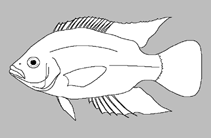http://www.fishbase.org/Summary/speciesSummary.php?genusname=Tylochromis&speciesname=bangwelensis ---> http://192.134.151.83/Summary/speciesSummary.php?genusname=Tylochromis&speciesname=bangwelensis
http://192.134.151.83/Summary/speciesSummary.php?genusname=Tylochromis&speciesname=bangwelensis ---> https://fishbase.mnhn.fr/Summary/speciesSummary.php?genusname=Tylochromis&speciesname=bangwelensis
https://fishbase.mnhn.fr/Summary/speciesSummary.php?genusname=Tylochromis&speciesname=bangwelensis ---> https://fishbase.mnhn.fr/summary/Tylochromis-bangwelensis.html
Tylochromis bangwelensis, Hump-back bream : fisheries

You can
sponsor
this page
Common name (e.g. trout)
Genus + Species (e.g. Gadus morhua)
-

-
About this page
-
Languages
-
User feedbacks
-
Citation
-
Uploads
-
Related species
-


 Hump-back bream
Upload your
photos
and
videos
Hump-back bream
Upload your
photos
and
videos
Google image
 No image available for this species;
No image available for this species;
drawing shows typical species in Cichlidae.
Teleostei (teleosts) >
Cichliformes
(Cichlids, convict blennies) >
Cichlidae
(Cichlids) > Pseudocrenilabrinae
Etymology:
Tylochromis:
Greek, tylos = callus + Greek, chromis = a fish, perhaps a perch (Ref.
45335
)
.
More on author:
Regan
.
Environment: milieu / climate zone / depth range / distribution range
Ecology
Freshwater; benthopelagic. Tropical
Africa: Luapula, Lake Bangwelu and surrounding swamps, and the Chambezi (upper Congo River basin) in Democratic Republic of the Congo and Zambia (Ref.
246
,
45616
,
52346
). Reports from the Luvua, upper Lualaba and lakes Mweru and Upemba (Ref.
2970
,
45616
) based on misidentifications (Ref.
52346
).
Length at first maturity / Size / Weight / Age
Maturity: L
m
11.5
, range 11 - 12 cm
Max length : 27.5 cm TL male/unsexed; (Ref.
52962
)
Short description
Morphology
|
Morphometrics
Dorsal
spines
(total): 13 - 15;
Dorsal
soft rays
(total): 14-16;
Anal
spines
: 3;
Anal
soft rays
: 7 - 8;
Vertebrae
: 28. Diagnosis: lower lateral line extending far forward (Ref.
52962
).
Predominant food is the lake-fly in its larval aquatic stages (Ref.
246
). Also feeds on plants; maternal mouthbrooder that does not pair-bond (Ref.
52307
). Max. length of 27.5 cm presumed to be TL.
Life cycle and mating behavior
Maturity
|
Reproduction
|
Spawning
|
Eggs
|
Fecundity
|
Larvae
Female mouth-brooder; breeding occurs during the rainy seasons and the young, a favorite prey for the tiger-fish, keep closer inshore among
Eleocharis
reed and other vegetation (Ref.
246
). Young fish still attached to the yolk sac can be found in the mouth of a parent which is at the verge of spawning again (Ref.
52961
). The species breeds during a single spawning period toward the end of the rainy season (Ref.
2774
). At highwater, the fish move from the lake to their breeding grounds in adjacent swamps to spawn (Ref.
52346
).
Stiassny, M.L.J.
, 1991. Tylochromis. p. 526-533. In J. Daget, J.-P. Gosse, G.G. Teugels and D.F.E. Thys van den Audenaerde (eds.) Check-list of the freshwater fishes of Africa (CLOFFA). ISNB, Brussels; MRAC, Tervuren; and ORSTOM, Paris. Vol. 4. (Ref.
5714
)
IUCN Red List Status (Ref.
130435
)
Least Concern (LC)
; Date assessed:
16 February 2009
CITES
Not Evaluated
Not Evaluated
Threat to humans
Harmless
Human uses
Fisheries:
FAO - Publication:
search
|
FishSource
|
More information
Countries
FAO areas
Ecosystems
Occurrences
Introductions
Stocks
Ecology
Diet
Food items
Food consumption
Ration
Common names
Synonyms
Metabolism
Predators
Ecotoxicology
Reproduction
Maturity
Spawning
Spawning aggregation
Fecundity
Eggs
Egg development
Age/Size
Growth
Length-weight
Length-length
Length-frequencies
Morphometrics
Morphology
Larvae
Larval dynamics
Recruitment
Abundance
BRUVS
References
Aquaculture
Aquaculture profile
Strains
Genetics
Electrophoreses
Heritability
Diseases
Processing
Nutrients
Mass conversion
Collaborators
Pictures
Stamps, Coins Misc.
Sounds
Ciguatera
Speed
Swim. type
Gill area
Otoliths
Brains
Vision
Tools
E-book
|
Field guide
|
Length-frequency wizard
|
Life-history tool
|
Point map
|
Classification Tree
|
Catch-MSY
|
Special reports
Check for Aquarium maintenance
|
Check for Species Fact Sheets
|
Check for Aquaculture Fact Sheets
Download XML
Summary page
|
Point data
|
Common names
|
Photos
Internet sources
AFORO (otoliths) |
Aquatic Commons
|
BHL
|
Cloffa
|
BOLDSystems
|
Websites from users
|
Check FishWatcher
|
CISTI
|
Catalog of Fishes
:
genus
,
species
|
DiscoverLife
|
ECOTOX
| FAO - Publication:
search
|
Faunafri
| Fishipedia |
Fishtrace
| GenBank:
genome
,
nucleotide
|
GloBI
|
Google Books
|
Google Scholar
|
Google
| IGFA World Record |
MitoFish
|
Otolith Atlas of Taiwan Fishes
|
PubMed
| Reef Life Survey | Socotra Atlas |
Tree of Life
| Wikipedia:
Go
,
Search
| World Records Freshwater Fishing |
Zoobank
|
Zoological Record
Estimates based on models
Phylogenetic diversity index (Ref.
82804
): PD
50
= 0.5000 [Uniqueness, from 0.5 = low to 2.0 = high].
Bayesian length-weight: a=0.01905 (0.00986 - 0.03683), b=3.00 (2.83 - 3.17), in cm total length, based on LWR estimates for this species & Genus-body shape (Ref.
93245
).
Trophic level (Ref.
69278
): 3.2 ±0.40 se; based on food items.
Generation time: 2.7 ( na - na) years. Estimated as median ln(3)/K based on 1
growth studies.
Resilience (Ref.
120179
): Medium, minimum population doubling time 1.4 - 4.4 years (tm=2-3; K=0.4).
Fishing Vulnerability (Ref.
59153
): Low to moderate vulnerability (30 of 100).
Price category (Ref.
80766
):
Unknown
.
Back to Search
Random Species
Back to Top
Accessed through:
Not available
FishBase mirror site :
localhost
Page last modified by :
mrius-barile
- 20 July 2016
Fatal error
: Uncaught ArgumentCountError: Too few arguments to function checkEcotox(), 1 passed in /var/www/html/summary/speciessummary.php on line 2304 and exactly 3 expected in /var/www/html/includes/speciessummary.lib.php:2579 Stack trace: #0 /var/www/html/summary/speciessummary.php(2304): checkEcotox() #1 {main} thrown in
/var/www/html/includes/speciessummary.lib.php
on line
2579
|